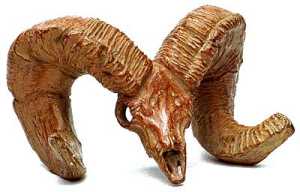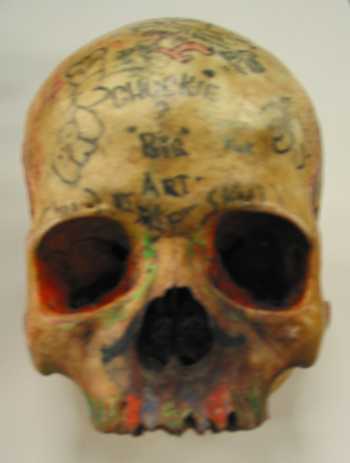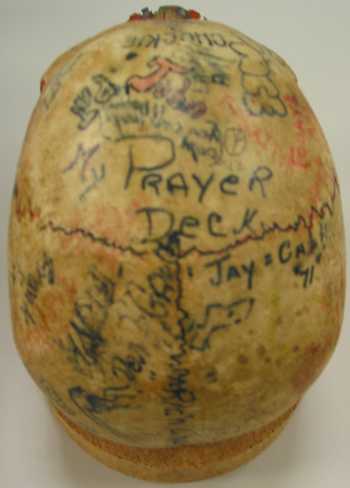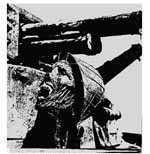


|
Growing
up in Texas, my idea of a trophy skull was the bones of a cow or a sheep
or a rattlesnake which would turn up from a hike in the hill country.
Invariably, these bones had been around for some time and were typically
bleached from the sun. The exception was strolling into a broken down shack
on the bayou once where I found the recent remains of a cow, hide semi-detached.

Out west, animal skulls acquire artistic value, as exemplified by David
Schaefer's bronze
sculpture of a bighorn sheep skull above.
So it was with some interest that I learned, upon attending Jan Burke's
and Paul Sledzik's talk on "Revealing the Evidence: Forensics in
Fiction" (at the 2002 Virginia
Festival of the Book), that the term "trophy skulls" also
refers to souvenirs of human skulls collected by soldiers in various wars.
And that forensic scientists must sometimes determine whether a human skull
is, in fact, a trophy skull when called upon to assist with a murder investigation.
 Trophy Skull of a Male Vietnamese (front) -
on display at the 2002 Virginia Festival of the Book
Trophy Skull of a Male Vietnamese (front) -
on display at the 2002 Virginia Festival of the Book
Jan Burke is the author of eight novels, including Flight and
the Edgar Award-winning Bones.
Paul Sledzik is a forensic anthropologist at the National Museum of Health
and Medicine in Washington, D.C.
| National Museum of Health and Medicine: NW corner of Washington DC.
495 beltway west to exit 31B Georgia Ave. south 2.5 miles. Look for black
wrought-iron fence on right. Through Walter Reed Army Medical Center gate
at Elder St. Show picture ID. Make immediate right onto service road past
loading docks, road makes sharp right turn stop sign, go 500 feet. U-shaped
driveway on right. Bldg. 54 (facing Dahlia). Park in driveway. Visitors
only have to show picture ID on weekends and evenings and parking pass is
free. |
As commander of the mid-Atlantic Disaster Mortuary Team, he assisted
in identifying disaster victims. He also participated in the work at the
Pennsylvania crash of September 11th.
Paul Sledzik's scientific research examines skeletal health and human
identification and it is this expertise which he brought to the discussion
of forensics in fiction. Recently, Jan Burke and Paul Sledzik teamed up
to write a short story, "The Haunting of Carrick Hallow", which
can be found in "Crime Through Time" (Edited by Sharan Newman,
Berkley Prime Crime Time: New York, 2000).
 Trophy Skull of a Male Vietnamese (back) - on
display at the 2002 Virginia Festival of the Book
Trophy Skull of a Male Vietnamese (back) - on
display at the 2002 Virginia Festival of the Book
To learn more about trophy skulls, I turned to the web - which suggests
that the practice of collecting and displaying human skulls dates back centuries:
Before Vietnam, there was Guadalcanal in World War II.
"We boiled the
flesh off enemy skulls"
"Japanese skulls were much-envied trophies among U.S. Marines in
the Pacific theater during World War II. The practice of collecting them
apparently began after the bloody conflict on Guadalcanal, when the troops
set up the skulls as ornaments or totems atop poles as a type of warning.
 |
| Propaganda
and dehumanization - The charred, decapitated head of a Japanese soldier
placed as a war trophy on a knocked-out tank by U.S. troops on Guadalcanal
from Life.[1943, Life Magazine] |
The Marines boiled the skulls and then used lye to remove any residual
flesh so they would be suitable as souvenirs. U.S. sailors cleaned their
trophy skulls by putting them in nets and dragging them behind their vessels.
Winfield Townley Scott wrote a wartime poem, 'The U.S. Sailor with the Japanese
Skull" that detailed the entire technique of preserving the headskull
as a souvenir.
 |
| Propaganda
and dehumanization - The charred, decapitated head of a Japanese soldier
placed as a war trophy on a knocked-out tank by U.S. troops on Guadalcanal
from Life.[1943, Life Magazine] |
In 1943 Life magazine published the picture of a U.S. sailor's girlfriend
contemplating a Japanese skull sent to her as a gift - with a note written
on the top of the skull. Referring to this practice, Edward L. Jones, a
U.S. war correspondent in the Pacific wrote in the February 1946 Atlantic
Magazine, "We boiled the flesh off enemy skulls to make table ornaments
for sweethearts, or carved their bones into letter-openers."
On occasion, these "Japanese trophy skulls" have confused police
when they have turned up during murder investigations. It has been reported
that when the remains of Japanese soldiers were repatriated from the Mariana
Islands in 1984, sixty percent were missing their skulls."
Source: Kenneth V. Iserson, M.D., Death to Dust: What happens to Dead
Bodies?, Galen Press, Ltd. Tucson, AZ. 1994. p.382. |
Before World War II, there was Chele
Kula.
 Chele Kula 1809
Chele Kula 1809
And then, there is the never-ending discussion about the origin of human
skulls - which may or may not exist - on the campus of Yale University.
In a report "American Journal" aired earlier this year, an
Apache tribal leader discussed claims that George Bush's father dug up Geronimo's
skull (at Fort Sill, OK) and took it back to Yale. He even showed us a purported
photo of the skull inside the secret society's "Tomb" on the Yale
campus.
The S&B Society has denied having Geronimo's skull, but -- according
to the Apache gentleman -- admitted possessing the skull of an Indian child.
A cook who works at the S&B facility confirmed to us that a number
of human skulls can be found within.
To identify those human remains, you might ask former - President George
Bush; Texas Gov. George
Bush, Jr; Senators Kerry or Chafee; or Bill Buckley and his writer son
Chris. All are S&B members.
Yours in search of true legends:
Mark Sauter (August 8, 1996)
Investigative Correspondent
"Inside Edition" |
If you have knowledge of or experience with trophy skulls or have interesting
stories deriving from your participation in the 2002 Virginia Festival of
the Book, please send them to george@loper.org where the most representative
comments will be placed on my web site with full attribution.
|









